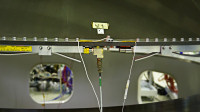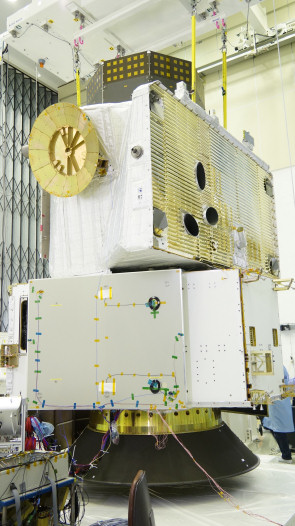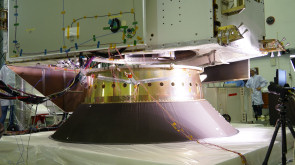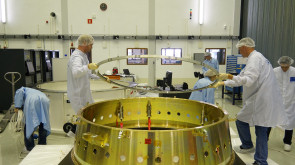#09: BepiColombo Composite Spacecraft Separation Shock Testing
27 August 2012
The BepiColombo Mercury Composite Spacecraft Structural and Thermal Model has undergone testing to demonstrate that it can withstand the shocks induced by the jettisoning of the launcher fairing and by the separation of the spacecraft stack from the launch vehicle adapter.In early August, the Structural and Thermal Model (STM) of the BepiColombo Mercury Composite Spacecraft (MCS) underwent tests at ESA's European Space Research and Technology Centre (ESTEC) in Noordwijk, the Netherlands that simulated two of the mechanical shocks it will experience during the launch process.
The MCS will be connected to the upper stage of the Ariane 5 launcher by the Launch Vehicle Adapter (LVA), which transfers the mechanical loads from the top of the launch vehicle upper stage to the launcher interface ring on the underside (-Z face) of the MCS.
The first test addressed the shock caused by the separation of the launcher fairing; the second simulated the separation of the MCS from the LVA.
Fairing Jettison
While the MCS is being carried into orbit, it will be protected from aerodynamic forces and aerothermal effects by the launch vehicle fairing. Once the launcher exits Earth's atmosphere, the fairing's task is over and it will be jettisoned. To do this, the pyrotechnic fasteners securing the fairing to the launch vehicle will be fired and the fairing will be separated into two pieces and propelled away from the payload, again using pyrotechnics, allowing it to fall away. This pyro firing that detaches the fairing will cause a mechanical shock that will be transferred through the LVA to the spacecraft stack.
| Simulation of fairing jettison shock. Credit: ESA. (For larger versions of this video click here) |
 |
| Close up of the 'SHOGUN'. Credit: ESA |
To simulate this shock, the MCS with the LVA attached was suspended from an overhead crane and a Shock Generation Unit (SHOGUN) was bolted to the bottom of the LVA. The SHOGUN contained a small amount of explosive sandwiched between its LVA interface and a metal band. When the explosive was detonated, the sections of the band deformed and a mechanical shock was induced in the base of the LVA. Accelerometers mounted at strategic locations on the spacecraft stack measured the effect of the shock.
Separation from the Launcher
Once the upper stage and its payload have arrived in the required orbit, the MCS will separate from the launcher. To achieve reliable separation, the MCS will be attached to the LVA using a clamp band. At separation, a pyrotechnic device will open the clamp band and springs will push the spacecraft away from the upper stage. Again, the firing of the pyrotechnic device causes a mechanical shock to be transmitted to the spacecraft stack.
| Simulation of spacecraft/ launcher separation shock. Credit: ESA (For larger versions of this video click here) |
To simulate this shock, the configuration from the previous test, with the MCS/LVA suspended from an overhead crane, was retained. Compressed gas, rather than a pyrotechnic device, was used to open the clamp band and the LVA dropped onto blocks of foam rubber. Again, accelerometers monitored the effect on the spacecraft stack.
About BepiColombo
BepiColombo is Europe's first mission to Mercury. It is scheduled to launch in August 2015 and arrive at Mercury in January 2022. It will endure temperatures in excess of 350 °C and gather data during a one-year nominal mission, with a possible one-year extension. The mission comprises two spacecraft: the Mercury Planetary Orbiter (MPO) and the Mercury Magnetospheric Orbiter (MMO). During the journey to Mercury, the MMO will be shielded from the Sun by the Magnetospheric Orbiter Sunshield and Interface Structure (MOSIF), which also provides the interface between the MMO and the MPO. The fourth component of the composite spacecraft stack is the Mercury Transfer Module (MTM), whose primary task is to provide solar-electric propulsion for the journey to Mercury.
BepiColombo is a joint mission by ESA and the Japan Aerospace Exploration Agency (JAXA), executed under ESA leadership. The Prime Contractor for BepiColombo is Astrium GmbH.











